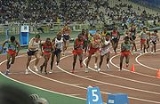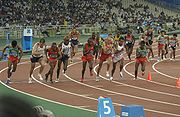
Athletics at the 2004 Summer Olympics - Men's 10,000 metres
Encyclopedia
The men's 10,000 metres was one of 23 track events of the athletics at the 2004 Summer Olympics
, in Athens
. It was contested at the Athens Olympic Stadium on August 20, by a total of 24 athletes from 14 nations. No preliminary rounds were held at this distance, since the number of competitors allowed a direct final.
The Ethiopia
ns were in control throughout the distance. A leading group of five runners crystallised. As Bekele
and Sihine
turned up the pace with two kilometres left, Tadese, Kiprop and reigning champion Gebrselassie
, who was running with a calf
injury, were not able to keep up. Bekele, the world record holder, assured his victory with a brilliant Olympic record finish (27:05.10 minutes), completing the final 400 metres in less than 54 seconds.
(NOC) was permitted to enter up to three athletes, provided they had run below 27:49.00 minutes during this period in IAAF
-sanctioned meetings or tournaments. If an NOC had no athletes qualified under this standard, it could enter up to one athlete that had run below 28:06.00 minutes.
 All times shown are in minutes. The following abbreviations are used:
All times shown are in minutes. The following abbreviations are used:
The final was held on August 20.
Athletics at the 2004 Summer Olympics
At the 2004 Summer Olympics, the athletics events were held at the Athens Olympic Stadium from August 18 to August 29, except for the marathons , the race walks , and the shot put...
, in Athens
Athens
Athens , is the capital and largest city of Greece. Athens dominates the Attica region and is one of the world's oldest cities, as its recorded history spans around 3,400 years. Classical Athens was a powerful city-state...
. It was contested at the Athens Olympic Stadium on August 20, by a total of 24 athletes from 14 nations. No preliminary rounds were held at this distance, since the number of competitors allowed a direct final.
The Ethiopia
Ethiopia
Ethiopia , officially known as the Federal Democratic Republic of Ethiopia, is a country located in the Horn of Africa. It is the second-most populous nation in Africa, with over 82 million inhabitants, and the tenth-largest by area, occupying 1,100,000 km2...
ns were in control throughout the distance. A leading group of five runners crystallised. As Bekele
Kenenisa Bekele
Kenenisa Bekele is an Ethiopian long-distance runner, who holds the world record and Olympic record in both the 5000 metres and 10,000 metres events...
and Sihine
Sileshi Sihine
Sileshi Sihine is an Ethiopian long-distance runner.Sihine achieved a silver medal in the 10,000 metres at the 2004 Athens Olympics and the 2008 Beijing Olympics as well as at the 2005 World Championships and 2007 World Championships as well as a bronze medal in 2003...
turned up the pace with two kilometres left, Tadese, Kiprop and reigning champion Gebrselassie
Haile Gebrselassie
Haile Gebrselassie is an Ethiopian long-distance track and road running athlete. He won two Olympic gold medals over 10,000 metres and four World Championship titles in the event. He won the Berlin Marathon four times consecutively and also had three straight wins at the Dubai Marathon...
, who was running with a calf
Calf (anatomy)
In human anatomy the calf is the back portion of the lower leg . In terms of muscle systems, the calf corresponds to the posterior compartment of the leg. Within the posterior compartment, the two largest muscles are known together as the calf muscle and attach to the heel via the Achilles tendon...
injury, were not able to keep up. Bekele, the world record holder, assured his victory with a brilliant Olympic record finish (27:05.10 minutes), completing the final 400 metres in less than 54 seconds.
Medalists
Qualification
The Olympic qualification period for the athletics ran from January 1, 2003 to August 9, 2004. For this event, each National Olympic CommitteeNational Olympic Committee
National Olympic Committees are the national constituents of the worldwide Olympic movement. Subject to the controls of the International Olympic Committee, they are responsible for organizing their people's participation in the Olympic Games...
(NOC) was permitted to enter up to three athletes, provided they had run below 27:49.00 minutes during this period in IAAF
International Association of Athletics Federations
The International Association of Athletics Federations is the international governing body for the sport of athletics. It was founded in 1912 at its first congress in Stockholm, Sweden by representatives from 17 national athletics federations as the International Amateur Athletics Federation...
-sanctioned meetings or tournaments. If an NOC had no athletes qualified under this standard, it could enter up to one athlete that had run below 28:06.00 minutes.
Records
World and Olympic records prior to the Games.| World Record | 26:20.31 |  Kenenisa Bekele Kenenisa BekeleKenenisa Bekele Kenenisa Bekele is an Ethiopian long-distance runner, who holds the world record and Olympic record in both the 5000 metres and 10,000 metres events... |
Ostrava Ostrava Ostrava is the third largest city in the Czech Republic and the second largest urban agglomeration after Prague. Located close to the Polish border, it is also the administrative center of the Moravian-Silesian Region and of the Municipality with Extended Competence. Ostrava was candidate for the... (Czech Republic Czech Republic The Czech Republic is a landlocked country in Central Europe. The country is bordered by Poland to the northeast, Slovakia to the east, Austria to the south, and Germany to the west and northwest.... ) |
June 8, 2004 |
|---|---|---|---|---|
| Olympic Record | 27:07.34 |  Haile Gebreselassie Haile Gebreselassie |
Atlanta (USA) | 29 July 1996 |
Results

- DNF denotes "did not finish"
- OR denotes "Olympic record"
- NR denotes "national record"
- SB denotes "season best"
The final was held on August 20.
| Rank | Athlete | Time | |
|---|---|---|---|
| |
27:05.10 | OR | |
| |
27:09.39 | ||
| |
27:22.57 | NR | |
| 4 | 27:25.48 | SB | |
| 5 | 27:27.70 | ||
| 6 | 27:41.91 | SB | |
| 7 | 27:46.61 | ||
| 8 | 27:57.09 | ||
| 9 | 27:57.61 | ||
| 10 | 28:01.94 | SB | |
| 11 | 28:10.75 | ||
| 12 | 28:14.53 | ||
| 13 | 28:17.08 | ||
| 14 | 28:23.39 | ||
| 15 | 28:26.26 | ||
| 16 | 28:29.87 | ||
| 17 | 28:43.19 | ||
| 18 | 28:55.96 | ||
| 19 | 29:06.50 | ||
| 20 | 29:06.55 | ||
| 21 | 29:38.05 | ||
| — | DNF | ||
| — | DNF | ||
| — | DNF |

